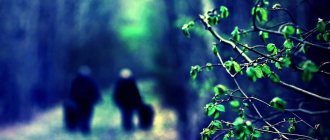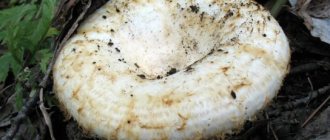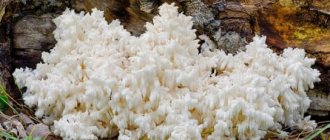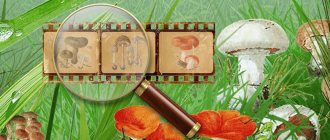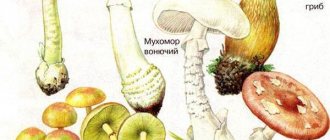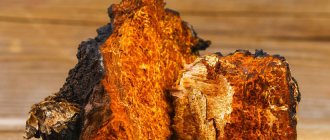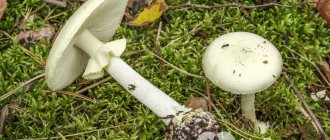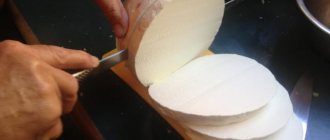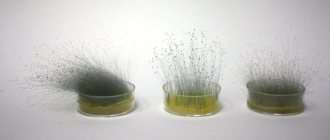Toadstools are poisonous and have a high mortality rate. Especially if you do not seek help from a doctor within the first 24 hours after poisoning. The most toxic toadstools are white and pale. To avoid becoming a victim of these terrible killers, you need to clearly understand what they look like and how they differ from some edible mushrooms that are similar in appearance to them.
Toadstool mushrooms (Photo from pikist.com)
Educational information about mushrooms for children. The world. Death cap
“Every mushroom is picked up, but not every mushroom is put in a box” - this popular proverb applies to all poisonous mushrooms, but toadstool should not only be put in a box, but also taken into hands.
That's how dangerous she is! Death cap
I will tell you in detail what the pale toadstool looks like, and you try to remember well the distinctive features of this most dangerous mushroom, so that if you see it in the forest, you will avoid it. The pale toadstool cannot be picked, cut with a knife, or even touched with your hands!
A young pale grebe looks like a matryoshka doll wrapped in a white diaper film. When the mushroom grows, the film bursts, the toadstool cap straightens and becomes dull gray, pale green or yellowish. The plates located at the bottom of the cap are greenish. The stem of the mushroom, thickened at the bottom, seems to be hidden in a cover, and under the cap it has a fringe - its most important feature.
SO, REMEMBER!
Pale toadstool is a faded mushroom. At the root of the mushroom there is a club-like tuber, which is wrapped in a white sheath. There is a fringed ring on the foot of the pale grebe under the cap!
Sometimes the toadstool is confused with russula or champignons.
But the russula has neither a fringe under the cap nor a thickening at the bottom of the stem.
The champignon also does not have a thickening on the stem, and the plates of the cap are not white, but pinkish or violet-brown.
Death cap
The cap is greenish-whitish.
The plates - both young and old - are white.
The leg is white, fringed, thickened at the bottom, covered with a sheath.
The pulp is white.
The most important thing is the “cuff” on the leg, a kind of collar under the hat.
If you come across an unfamiliar pale mushroom, never touch it, pick it, or put it in a basket!
It acts painlessly, imperceptibly and quickly, and when the patient becomes very ill, it is no longer possible to save him. After all, there are no antidotes for the poisons of the toadstool yet!
Questions for consolidation
1. What does a toadstool look like?
2. By what signs can it be distinguished from russula?
3. What is the difference between toadstool and champignon?
4. How do the poisons of the toadstool act on the human body?
5. Why is this mushroom called “forest death”?
6. How should a mushroom picker behave in order to avoid poisoning from a poisonous mushroom?
Source
How to get rid of this mushroom in the garden
If you find a group of these mushrooms, you should uproot everything. After this, you need to remove the mycelium from the ground by lifting its top layer and removing all the threads. If this is not possible, you need to leave the soil layer raised for 3-4 days. The rays of the Sun will remove all remnants of the mycelium. Afterwards, you should carefully weed the place where the mushroom threads have sprouted. To avoid this problem in the future, you need to remove all rotten wood from the area and constantly remove weeds with tall grass. This must be done so as not to create ideal conditions for the appearance of Toadstool: areas with wet soil.
Presentation, report on the surrounding world on the topic Pallid grebe (grade 2)
Presentation on the world around us on the topic Pallid grebe (2nd grade), subject of presentation: Children's presentations. This material in pptx (PowerPoint) format contains 11 slides; use the player to view. A presentation on a given topic can be downloaded at the bottom of the page by sharing the link on social networks! Presentations are taken from public access or uploaded by their authors, the site administration is not responsible for the accuracy of the information in them, all rights belong to the authors of the presentations and can be deleted at their request.
Distribution of the fungus in nature
In what places does the toadstool grow? Where should you expect to encounter this insidious mushroom?
Toadstools are found quite often in nature. Their main distribution area is the temperate zone of Eurasia (in particular, Russia, Belarus and Ukraine) and North America. They grow both singly and in groups. The growing season begins around the end of August and lasts until the beginning of November (until the first serious frost).
The pallid grebe prefers mixed or light deciduous forests, ideally broad-leaved ones. He likes to “settle” under beeches, hornbeams, oaks, lindens, and hazel bushes. Often found in city parks and squares. Sometimes lives in birch groves. But meeting her in a pine forest is very difficult. The grebe does not tolerate sandy substrates, preferring fertile humus soils.
Slides and text of this presentation
Poisonous and terrible, And deadly to everyone. With a thin ragged leg, This is...
Pale toadstool is a very poisonous mushroom, poisoning with which is extremely dangerous for human life. It belongs to the fly agaric genus and grows in fertile and well-lit soils of deciduous and mixed forests. Most often they are located in groups, but sometimes you can see that the mushroom grows separately, on its own. They can be found in late summer or early autumn.
The severity of the symptoms of poisoning and the severity of the patient’s condition depend on the amount of poison entering the body. The course of the disease can be divided into several periods.
The first period can last from 7 to 40 hours. There are no signs of illness yet. This is the insidiousness of the toadstool: by the time the first signs of poisoning appear, a larger amount of poison has already managed to get into the blood and begin to destroy the body.
Symptoms and signs of poisoning
The second period lasts from 1-2 to 6 days. Its symptoms appear unexpectedly and suddenly. These include: severe diarrhea; repeated severe vomiting; severe thirst: it is impossible to quench it, drinking water leads to increased vomiting; severe cramps, abdominal pain; severe dehydration, which leads to a sharp decrease in blood pressure, pale skin, and increased heart rate; blurred vision, dizziness, headaches; convulsions,
Symptoms and signs of poisoning
The third period is typical for poisoning with the poison of the toadstool. It is also called the stage of imaginary recovery. Its duration is about a day. The patient’s well-being suddenly improves dramatically, however, if you do a biochemical blood test, you can see liver dysfunction. The patient suffers from severe drowsiness. Often after 10-12 hours collapse suddenly develops and the person dies. This happens in the case of severe poisoning from the poison of the pale grebe.
Symptoms and signs of poisoning
Since the first symptoms of poisoning by toadstool begin to make themselves felt only when a sufficiently large amount of time has passed after the poison has penetrated the body, first aid is ineffective, and the result will be zero. It is necessary to consult a doctor as soon as possible, ideally call an ambulance.
First aid before the doctor arrives
Is it possible to use the toadstool for good purposes?
The toadstool is poisonous, all entwined with silks, brittle and pale, you look harmless, but in reality you are an evil witch. We recognize you by sight!
Source
Names of inedible and poisonous mushrooms of the Chelyabinsk region
The green areas of the region are replete with not only edible, but also toxic varieties, the use of which can provoke unpleasant consequences. Some poisonous mushrooms can easily be confused with good ones, so you need to study all types of forest fruits, without exception.
Toadstool pale
Pale toadstool is the most dangerous mushroom, even a small piece of which is fatal. The mushroom can be confused with white mushroom or forest champignon. However, there are certain signs of a toadstool that will help the collector not to make a mistake - this is the presence of a white skirt and a volva-case with a leg growing from it.
Satanic mushroom
This barrel-shaped mushroom can only be confused with boletus mushrooms, because some of their varieties have an unusual color. So the satanic mushroom grows on a bright red pot-bellied leg, has a brownish or grayish lumpy cap and yellow flesh, which instantly turns blue upon contact with the external environment. What gives these poisonous fruits away is their disgusting smell, reminiscent of rotten onions.
Red fly agaric
It is almost impossible to confuse the fly agaric with edible fruits, thanks to its bright red cap with motley white splashes. In addition, it is not as poisonous as toadstool, although this does not mean that these fruits can be used in cooking.
False fox
The orange talker - the chanterelle's double - has a brighter orange color and a thin stem tapering downward, while real mushrooms, on the contrary, slightly expand downward and have a fleshier base and cap.
Yellow-skinned champignon
The outwardly inedible mushroom can easily be confused with a forest species, however, in a real champignon, the hymenophore has a brown or pinkish color. But in terms of taste and smell, this is much more difficult to do, since instead of the pleasant aroma of raw wood, these fruiting bodies emit a nauseating chemical smell, which intensifies during cooking.
Experts advise not to collect fruits that grow near production facilities and along busy highways, even if we are talking about edible varieties. This is explained by the fact that mushrooms tend to absorb all toxins and harmful substances that are not neutralized even after heat treatment.
What does the poisonous white toadstool mushroom look like (with photo)
The white toadstool, or stinking fly agaric (Amanita virosa) is a deadly poisonous mushroom.
The cap is up to 6-12 cm, convex, then flat-convex, sometimes sticky, white, in the central part the color of butter, often with white remnants of the cover at the edges. The plates are wide, frequent, free, white.
As you can see in the photo, the leg of this toadstool is white, 1-2 cm thick, 10-15 cm long, covered with flaky white scales with a volva at the bottom:
The ring on the stem is white flaky. The pulp is white with an unpleasant taste and smell of chlorine. Spore powder is white.
The white toadstool (fly agaric) grows in mixed and coniferous forests, among mosses on peat soils.
Found in August and September.
Light-colored floats (they are without a ring) and champignons (they are without a volva, with pinkish plates) are similar to a white toadstool.
The white grebe is no less poisonous than the pale grebe, but there are fewer cases of poisoning with the white grebe, since it has an unattractive “toadstool” appearance and an unpleasant odor.
How to recognize unsuitable mushrooms
Before you go into the forest, you need to study what edible mushrooms look like and find out the characteristics of toadstools. Here are some types of poisonous mushrooms in the Sverdlovsk region:
- Undoubtedly, the easiest way to distinguish a fly agaric is by its beautiful cap. The motley red crown with white specks gives it away from afar.
- But false foam poses a danger to uninformed mushroom pickers. It is distinguished by the color of the plates. Good mushrooms have a creamy color and do not darken. In the poisonous brick honey fungus, the plates are slightly lighter and become brown over time. Gray-yellow false foam has plates of the same color.
- The pale grebe is distinguished by the presence of a skirt. Many other poisonous mushrooms have the same structure.
- A great similarity was noticed between the gall fungus and the white one. This type of grebe has a tubular layer under the cap that is dirty pink in color. A mesh pattern is visible on the leg.
- Anyone can recognize a false fox - it is very similar to its double, although it does not belong to this family. Not so long ago it began to be classified as a conditionally edible mushroom body. And yet, these mushrooms are not recommended to be eaten, since they are very poorly absorbed by the body and cause serious problems associated with digestion.
Poisonous mushroom toadstool: photo and description of the plant
Pale toadstool is a poisonous lamellar mushroom with a strong toxic effect. It grows from the end of August until the first autumn frosts, preferring deciduous and broad-leaved forests. Grows under oaks, maples and pines. It is rare, but in some years it produces a large harvest. Pale toadstool is a fairly moisture-loving mushroom and it grows at a time when many edible mushrooms are developing in the forest: russula, white mushrooms, oak mushrooms, boletus mushrooms and many others. During this period, grebes are found not only in deciduous forests. They are also found in pine plantings.
The cap is up to 10-12 cm, convex, then flat-convex, smooth yellow-green, olive-green, darker towards the center, radially fibrous, sometimes with whitish remains of the veil. There is a form with a white cap. The bell-shaped cap of young mushrooms becomes prostrate with age, and in some varieties it becomes depressed. At high air humidity, its shiny, silky-to-touch surface is covered with a thin layer of mucous plaque, sometimes with mealy flakes. The edges of the cap are smooth, even, with hanging remains of the white cover. The plates are wide, frequent, free, white.
As for the description of the leg of the pale grebe, it is round, slightly widened at the bottom, where it forms a small tuber, immersed in a free sac-like volva. The color of the leg is white or pale olive, with a subtle moiré pattern. It grows to a height of 8-10 cm, and its diameter is approximately 1–2 cm. At the top of the leg of the pale grebe plant there is a wide white ring, by which the pale grebe can be easily distinguished from its edible counterparts and thereby avoid a fatal mistake . The pulp is white, sweetish, with a faint sickly sweet odor. Spore powder is white.
Found in August - September.
These photos show white and pale grebes, the description of which you read above:
All proven cases of fatal poisoning of people with mushrooms are associated with the consumption of toadstool, when it was mistaken for russula of a suitable color or for champignon.
The greatest number of poisonings occurs in July - October, the growing season of the toadstool.
Next, you will learn how to distinguish toadstool from edible mushrooms.
Inedible mushrooms of Bashkiria
70% of the mushroom mass in the forests of Bashkiria are inedible and poisonous mushrooms. If the former taste bad and can only spoil the dish, then the latter can cause severe poisoning, even death. To protect yourself from eating poisonous mushrooms, you should know all of them by name - with signs and places of growth. Let's see what deadly mushrooms can be found in the forests of Bashkiria.
A report on the peculiarities of mushroom picking in October. Experts talk about the rules for collecting mushrooms that will help avoid poisoning:
fly agaric
Description. Red fly agaric is a beautiful mushroom with a bright cap topped with white scaly specks.
Where does it grow and when? Grows in any forest. Fly agaric is capable of creating mycorrhiza with any trees. Growth begins at the end of July.
Who can be confused with? It is impossible to confuse red fly agarics - there are no such bright and noticeable mushrooms in the forest anymore. In addition to red, there are other poisonous varieties - panther, stinking, toadstool. But there are also edible fly agarics - for example, gray-pink and Caesar. They are even cultivated artificially. For this purpose, spore-bearing caps are used - they are cut and mixed with the soil.
Death cap
Description. The pale grebe and all its relatives are very similar in shape, the differences are only in color and nuances. They all have one thing in common - they are terribly poisonous. The color of the cap may vary in shades - there are greenish, olive, and grayish toadstools. Hats are flat or hemispherical, with smooth edges. If the pulp is broken, its color does not change. Toadstool tastes sweet, but does not smell anything. The lower part of the leg has a thickening with a film, and on the upper part there is a film ring. The tuberous thickening at the bottom of the leg is the main difference between the toadstool, by which it can be unmistakably identified.
Where does it grow and when? Grows alone and in groups. It grows everywhere, but prefers mixed and deciduous forests. Growth begins in late summer.
Who can be confused with? Inexperienced mushroom pickers may mistake toadstools for russula, green mushrooms, or champignons.
Poisonous row
Description. In the poisonous gray row, the edges of the cap are turned inward. The color of the hat is off-white, brownish, gray. The pulp is white, with a floury smell and taste. The hat has densely arranged scales. The leg is covered with a powdery coating. Greenish-yellow plates grow to the stem.
Where does it grow and when? Prefers sandy soils covered with moss. Grows in coniferous forests, pine trees, parks and gardens, fields and meadows. The ripening period is August-October.
Who can be confused with? Can be confused with edible rows. There are many conditionally edible mushrooms in their family.
False honey mushrooms (sulfur-yellow)
Description. Sulfur-yellow honey mushrooms have strong caps, reaching a diameter of 7 cm. At first, the caps are spherical, and as the mushroom grows, they straighten out. The color of the caps is bright yellow. There are orange spots in the center. The legs are thick and hollow. The color is similar to the hat. The pulp on the break is yellow, smells unpleasant, and tastes bitter.
Where does it grow and when? They bear fruit from mid-June until the snow. They grow in forests of all types and in fields. Grows on tree trunks and rotten stumps. Colonies can contain up to 20 individuals.
Who can be confused with? Usually confused with edible honey mushrooms. The main difference from real mushrooms is the absence of scales. Real mushrooms - summer and autumn - have brown legs, like their hats.
Cobweb
Description. There are about 400 species of spider webs. Among them there are both poisonous and edible. They are practically not collected - they look like toadstools. Many smell bad. Two mushrooms are considered deadly poisonous - the mountain mushroom and the beautiful cobweb mushroom. The cap of the mountain web spider is brown-red or orange, the plates are of the same color. The leg is yellowish, it has longitudinal rusty fibers. The most beautiful cobweb is similar to the mountain one. The young have a cobweb-like coat of yellow-ocher color.
Where does it grow and when? Cobwebs grow in coniferous forests and love moss and moist, swampy soil.
Who can be confused with? Can be confused with the edible web spider, which has a brown, fleshy cap with inwardly curved edges.
On the territory of Bashkiria there are zones that differ in relief and climate, so different types of mushrooms are found here. The main thing is not to confuse an edible mushroom with false doubles, and not to put a poisonous mushroom in the basket.
How to distinguish toadstool from edible mushrooms
By carefully assessing each mushroom picked, the toadstool can be distinguished from other edible mushrooms. Unlike the colors of the rainbow, you don’t want to look at them. And the shape of the mushroom is quite attractive and slender. The ratio of the height of the stem and the diameter of the cap is in a harmonious combination.
When describing the toadstool mushroom, the following characteristic features are distinguished: at the base of the thin cylindrical stalk there is a tuberous thickening (club), and the mushroom collar seems to grow out of the cover, and in the middle of the stalk there is a ring of film. Green russula, with which the toadstool is also confused, does not have them.
The plates of pale toadstools are white (both young and old specimens), the spores are colorless. In mushrooms, with which toadstool is most often confused, the underside of the cap is pinkish-brown, darkening to black as the mushroom ripens.
But the most important difference between toadstool and champignon is the smell. Toadstool has no smell, but champignon has an anise or almond smell.
If you do not know how to distinguish a toadstool, it is better to avoid the suspicious mushroom.
Tips for beginner mushroom pickers
Quiet hunting can be a real pleasure, and wild mushrooms taste richer and more pleasant than those grown in industrial conditions.
To avoid unpleasant consequences, you need to follow simple but effective recommendations:
- collect only known mushrooms in which you are 100% confident;
- do not pick mushrooms near highways or industrial enterprises;
- At first, it’s better to invite a knowledgeable person to pick mushrooms several times;
- Do not pick edible mushrooms if poisonous ones grow nearby.
It is imperative to follow these simple rules so as not to endanger yourself and your family.
Toadstool poisoning
Pale toadstool is a very poisonous mushroom, poisoning with which is extremely dangerous for human life. It belongs to the fly agaric genus and grows in fertile and well-lit soils of deciduous and mixed forests. Most often they are located in groups, but sometimes you can see that the mushroom grows separately, on its own. They can be found in late summer or early autumn.
The toadstool is the most poisonous mushroom in the world.
Edible species
In the Urals, mushrooms are found everywhere and during any season. But not all of them are edible. To avoid mistakes, it is better to get acquainted with edible species in advance. The most popular in this region include the following:
- White;
- Boletuses;
- Boletus mushrooms;
- Butter;
- Saffron milk caps;
- Volnushki;
- Russula;
- Squeakers;
- Milk mushrooms;
- Rogatiki.
Summer and autumn honey mushrooms are so common that some people pass by, considering them something like weeds.
White
The white mushroom is called the king of the forest
The porcini mushroom cannot be confused with others; it is memorable at first sight. He is called the "king of the forest." In the Urals they came up with other names for it:
It has a beautiful powerful stem, cylindrical at the bottom and tapering towards the cap. Her color is white. The surface of the cap is brown, sometimes slightly reddish. The pulp is dense, with a strong mushroom aroma. At the bottom of the cap there is a spongy layer of white or slightly yellowish color. The color never changes when cut. Even when dry, the pulp remains snow-white
This is an important quality of the mushroom. This is why the mushroom is nicknamed “white”
Boletus
The boletus has a second name - redhead, which it received among the people because of the color of its cap. And also - aspen, kvasyuk, obabok, goose. The lower (spore-bearing) layer of its cap becomes brown with age. The shape of the leg is cylindrical, reaching a height of 18 cm. A mesh consisting of dark scales is clearly visible on it.
A characteristic feature is the blue discoloration of the cut. The aroma is strong and pleasant. The pulp is dense, homogeneous, soft. Boletuses grow in deciduous and mixed forests under aspens and other deciduous trees. The best collection time is from July to the end of September.
boletus
If an aspen boletus is found in the forest, then there will definitely be a boletus somewhere nearby. These forest organisms form mycorrhizae with birch, poplar, and aspen trees. Mass collection begins in June and continues until the end of August.
- the cap is dense and wide;
- cap diameter – up to 30 cm (maximum);
- cap color dark brown;
- the leg is slender, dense, uniform;
- the color of the leg is grayish and beige;
- height – up to 25 cm;
- the flesh is white;
- The aroma is pleasant and strong.
The pulp has a uniform structure. The cut never gets dark. When heat treated it becomes dark. For this reason, the boletus is called “black”.
Rogatiki
Experienced mushroom pickers will never pass by these strange-looking mushrooms. Mushroom spots sometimes do not change for many years due to the “perseverance” of the mycelium. Rogatiki are highly valued by chefs not only of the southern Urals, who use them to prepare delicacies, but also of other regions. It is the delicate aroma and pleasant taste that give dishes their uniqueness. Only young specimens that have white-pink flesh are taken. The shape of the mushroom resembles a branched sea coral with small horns, hence the name. Those who are unfamiliar with the cattail often pass by, considering it inedible.
Irina Selyutina (Biologist):
In addition to the above-mentioned mushrooms and milk mushrooms, they are loved in the Urals. To collect them you need to know where best to look for them. An experienced mushroom picker will never go to young forests where the height of the tree is no higher than the height of a person
He will pay attention to older landings. And in the old forests - rest assured, you will definitely meet your desired prey - milk mushrooms
It often happens that the fruiting bodies are hidden almost completely up to the cap in the ground. Then sticks come to the rescue, with which you can “pick” at suspicious tubercles. But some particularly “thoughtful” mushroom pickers perform this operation with specially grabbed small rakes. To find milk spots, you need not only experience, but also a “smell” for them. As it turned out, milk mushrooms have a characteristic smell that can never be confused with anything else. Its source is the fruiting bodies and mycelium of the fungus.
When going mushroom hunting, it is important to pay attention to the smallest details, because they are what help you find mushrooms and return home with a basket full of wonderful gifts from the forest.
Description of the distinctive characteristics of the pale grebe
What does a pale grebe look like? The body of this poisonous mushroom consists of a cap (its size ranges between 5 and 14 cm) and a stalk (its length can be from 8 to 15 cm, and its diameter can be from 1 to 3 cm).
Difference between toadstool and edible mushrooms.
A young mushroom is usually covered with a film. The color of the cap can vary from grayish and greenish to olive, and its shape can be either flat or hemispherical, with smooth edges. The pulp of the mushroom is white, juicy, its color does not change if the mushroom is damaged.
The taste of toadstool is sweetish, the smell is not very pronounced. The stem of the mushroom is colored in the same way as the cap; there may be a moire pattern; the shape is cylindrical, slightly thickened at the base.
On the upper part of the leg you can see a membranous ring, and in the lower part, where it is slightly thickened, there is also a film on the leg - already bag-shaped, it has a white or greenish color, its width varies between 3 and 5 cm. It is the presence of these films is the main characteristic by which one can distinguish the pale toadstool from other similar types of mushrooms.
Pale toadstool is very similar in appearance to some types of mushrooms that can be eaten. These include champignons, green russula, greenish russula, and floaty russula.
Important: membranous rings are the main distinguishing feature of the toadstool, since they are not found in the above species of mushrooms. That is why, when picking mushrooms, you should never cut them under the cap. You need to carefully examine the mushroom and make sure there are no filmy rings.
Poisonous mushrooms
Interesting Facts:
- most of the listed representatives are used as raw materials for the manufacture of medicines;
- fly agaric was used by the ancient Vikings before going into battle to reduce sensitivity to pain;
- inedible ones are eaten after long-term special processing;
- It is impossible to destroy poisonous representatives of the mushroom kingdom, because they are part of the ecosystem and play an important role in cleaning the environment;
- the most poisonous mushroom in the world, the toadstool;
- spring representatives are less toxic than those growing in the summer season (the information concerns conditionally poisonous specimens);
- The benefit of poisonous basiomycetes lies in the ability to use extracts from them in agriculture to create fungicides that prevent the spread of pests and fungal diseases.
Every mushroom picker should have a reminder: “don’t take mushrooms you don’t know”
You should choose the collection site carefully: basidiomycetes collected near the highway are especially toxic. The mushroom picking season begins in May-June and lasts until the first frost (this depends on the region where the mushroom picker lives)
Many poisonous varieties can be easily identified by cutting into the fruit body.
Deadly types of mushrooms are often disguised as edible ones (double mushrooms), so you need to be able to distinguish them.
Village Kashino
The leading place on my (personal) list is occupied by the village of Kashino, next to the city of Sysert. This area was described as a "mushroom picker's paradise" in a 1960 guidebook. There you can pick up butter. These mushrooms are perfect for those who love fried potatoes. Choose areas with low grass and mixed forest. You can get from Yekaterinburg by bus from the Southern Bus Station. The journey will take less than an hour.
Mount Volchikha
The next item on my list is for those who love salted and pickled mushrooms. In the area of Volchikha Mountain you can collect redfish and saffron milk caps. These mushrooms often coexist in clearings. They do not like to hide in the shade, so they are found in open places where the sun hits during the day. You can get there by train from Yekaterinburg, towards Revda. We get off at Sportivnaya station. The drive is about an hour.
The third place in the mushroom rating is occupied by forests near the city of Nevyansk. What can a mushroom picker pick up here? This is the “abode” of porcini mushrooms! They are attracted to coniferous forests, which is why they are even affectionately called “pine forests.” You can get to this area by any bus from the Northern Bus Station or by train. Get off at Nevyansk station. Next you need to go to the opposite side of the reservoir.
Lake Tavatuy
The fourth point in the rating is for those who prefer to walk less and collect by the handful. We will talk about honey mushrooms. They love swamps, dampness and stumps. Such places in the Sverdlovsk region can be found in the area of Lake Tavatuy. I recommend taking any bus towards Nevyansk. Next, after passing the “Tavatui” sign, you should get out and go to the side of the lake. For this route, be sure to wear waterproof shoes!
Village Kosulino
The sixth point will be useful for those who like to combine searching for mushrooms with a walk
If it is important for you to admire the Ural landscapes and would like to bring a basket of mushrooms for dinner, then the most suitable direction is the Peter Gronsky rocks. You can get there by train towards N
Tagila. Get off at station 479 km.
How to combine two goals? You can walk to the rocks, climb there, and take beautiful photos. Organize a picnic at the top. On the way back, going down to the station, pick mushrooms a little further than the tourist trails. Here your catch can be varied. There will be boletus and saffron milk caps, porcini mushrooms and boletus mushrooms. And... lots of blueberries!
Lake Sandy
The seventh point of our rating will be of interest to those who like to combine swimming and mushroom picking. Lake Peschanoe is located 20 km from Yekaterinburg along the Moscow Highway. Its depth is no more than 3.5 m. It warms up well, so you can swim until the end of August. And you can have picnics there throughout September!
Symptoms and signs of toadstool poisoning
Description of the pale grebe.
The pale grebe is deadly poisonous. How does it differ from a number of other poisonous mushrooms? The fact that no treatment, be it exposure to high temperatures or drying, can eliminate the toxic effect of its poison. To become poisoned, an adult only needs to eat 100 g of the mushroom, that is, about a third of the fruiting body. Children are especially susceptible to the effects of the toxins of this poisonous mushroom. What is characteristic is that their symptoms of poisoning begin primarily with convulsions; Another early symptom that is observed specifically in children is jaw cramping.
The peak of poisoning by this fungus is usually observed in August.
The severity of the symptoms of poisoning and the severity of the patient’s condition depend on the amount of poison entering the body. The course of the disease can be divided into several periods.
The first period can last from 7 to 40 hours. It is called latent because no signs of the disease have yet been observed. This is the insidiousness of the toadstool: by the time the first signs of poisoning appear, a larger amount of poison has already managed to get into the blood and begin to destroy the body.
The second period lasts from 1-2 to 6 days. Its symptoms appear unexpectedly and suddenly. These include:
Pain in the intestines and vomiting are the first signs of poisoning with toadstool.
The third period is typical for poisoning with the poison of the toadstool. It is also called the stage of imaginary recovery. Its duration is about a day. The patient’s well-being suddenly improves dramatically, however, if you do a biochemical blood test, you can see liver dysfunction. The patient suffers from severe drowsiness. Often after 10-12 hours collapse suddenly develops and the person dies. This happens in the case of severe poisoning from the poison of the pale grebe.
In the fourth period, poisoning of internal organs develops. The symptoms of this are:
In case of mushroom poisoning, you must first rinse your stomach.
Thus, a person usually dies within 10 days while the poison is in effect. It all depends on the condition of his heart and blood vessels. In cases of mild poisoning, a person returns to normal very quickly. In the case of moderate and severe poisoning, the patient requires long-term rehabilitation, the period of which can last from 2 weeks to several months.
As a rule, the body is able to fully recover: after about 2 weeks, jaundice disappears, after which gradually both the liver and other organs resume their activity in full. However, we should not forget that the probability of death with such poisoning is very high, since toxic hepatitis develops at lightning speed, and the signs of cardiovascular failure appear very clearly. Treatment, as a rule, does not bring results.
Poisonous species
Poisonous mushrooms should not be collected
Avid mushroom pickers are familiar with poisonous species and will not put them in the basket. They know the species that are on the black list. But sometimes even the most professional assemblers make mistakes. Before going into the forest, it is better to remember what poisonous and inedible mushrooms are found in the Urals. The most famous and frequently encountered include the following:
- false scent;
- Satanic;
- gall;
- death cap;
- red fly agaric;
- yellow-skinned champignon;
- false fox.
Death cap
This not very large and simple-looking fungus is dangerous. Its toxins are so strong that they can even penetrate the skin. Therefore, mushroom pickers do not touch the toadstool and leave it to grow in its place. One touch of it to completely edible mushrooms will make them poisonous.
According to the description, it looks like russula or honey fungus, but there is no “skirt” on the leg. Her hat is whitish or brown-olive. There is almost no smell, completely tasteless. It grows in birch groves from June until frost.
fly agaric
Among the poisonous ones, fly agaric is especially dangerous. Rare giant individuals are found in these forests, especially after good rains. It is after rains that fly agarics can easily be confused with russulas, because the white spots on their caps are washed away by water and they become almost invisible.
- the leg is tall and slender;
- the color of the leg is white (or yellowish);
- grow in height up to 23-30 cm;
- the cap is smooth, lamellar;
- the surface of the cap has a reddish color;
- there is a characteristic thin “skirt” under the hat;
- cap size – up to 30 cm.
Sometimes the cap is orange or pink, which makes it look like a russula. The pulp is odorless and yellow in color.
False fox
This representative of poisonous mushrooms grows in conifers. The hat looks like an orange-red funnel. The leg is hollow, cylindrical. These are autumn mushrooms. The mushroom spots are the same as those of the edible species common chanterelle, or cockerel.
Irina Selyutina (Biologist):
The fact that false chanterelles cannot be eaten was an axiom for all mushroom pickers until recently. Recently, evidence has appeared that the false chanterelle (orange talker) is classified as a conditionally edible mushroom. But with the following caveats:
- Before eating, this mushroom needs particularly careful pre-treatment;
- People with a weak digestive system are strictly prohibited from eating them.
However, there are no confirming factors for the edibility of orange talker, but there are reports of poisoning by this mushroom.
Weakly poisonous false chanterelles contain toxic compounds that are destroyed under the influence of high temperatures, or, in other words, thermolabile. However, at home it is impossible to determine whether they all collapsed during cooking and whether the mushroom has become harmless to health. Therefore, it will be safer to treat them as inedible mushrooms.
In the forests of the central zone, in the mountains of Kamchatka and on the Kola Peninsula, in the forest belts of the North Caucasus and the famous steppes of Kazakhstan, in the regions of Central Asia, more than 300 species of edible mushrooms grow, which lovers of “silent hunting” love to collect.Indeed, the activity is very exciting and interesting, which also allows you to feast on the harvest. However, you need to know about mushrooms so that poisonous ones do not end up in the basket along with edible ones, which, if eaten, can cause severe food poisoning. Edible mushrooms with photos, names and descriptions are offered for review by anyone interested in collecting mushrooms.
First aid before the doctor arrives
Since the first symptoms of poisoning by toadstool begin to make themselves felt only when a sufficiently large amount of time has passed after the poison has penetrated the body, first aid is ineffective, and the result will be zero. It is necessary to consult a doctor as soon as possible, ideally call an ambulance. In the hospital, the patient will undergo antitoxic therapy.
What can be done before the ambulance arrives? Anyone who may have gotten into their body with toadstool should cleanse their stomach, after which they should take activated charcoal at the rate of 1 g per 1 kg of person’s weight.
First symptoms of poisoning
Typically, symptoms do not appear immediately after eating a poisonous mushroom. This occurs only after 10-30 hours. Most often, the first symptom is a headache. Then the condition worsens: the stomach begins to ache, hallucinations appear. Afterwards, diarrhea with vomiting appears, and convulsions may begin. When the first symptoms change, the poison has already damaged the heart and kidneys. After 10 days the person dies. Already 40 g of Pale Toadstool is enough for a person’s life to begin to hang by a thread. But if you seek help immediately when the first symptoms appear, your chance of survival increases by 50 percent.
Pale grebe (Amanita phalloides)
In English-speaking countries, the pale grebe received the popular name “death cap” - “death cap”, “death cap”. Defining characters for this species include:
The cap of the Pale Toadstool is usually in shades of green or tan-brownish, although color is not the most reliable criterion for identifying this mushroom as it is quite variable. Sometimes white spots remain on the cap, remnants of the common blanket.
Description
Cap : 4-16 cm in diameter, at first almost round or oval. With growth, it becomes convex, then broadly convex, flat-convex, to flat in very old mushrooms. The skin of the cap is smooth, hairless, sticky in wet weather and shiny in dry weather. Color ranges from dull green to olive, yellowish to brownish (rare white "albino" forms usually grow together with forms with colored caps). In green- and olive-colored specimens, clearly visible dark radial fibers appear; in light-colored pale grebes, these fibers are less pronounced; in brownish-colored specimens, they can be difficult to see. On young caps there may be white patches, “warts”, remnants of the veil in which the fungal embryo develops, the same as on the well-known red fly agarics. But in the pale grebe, these “warts”, as a rule, disappear with age: they fall off or are washed away by rain.
Plates : free or almost free. White (sometimes with a slight greenish tint). Frequent, wide.
Leg : 5-18 cm tall and 1-2.5 cm thick. Cylindrical, central. More or less smooth, often narrowing towards the apex and widening to a thickened base. Bald or finely pubescent. White or with shades of the color of the cap, can be covered with a beautiful moire pattern.
Ring : white, large, strong, slightly hanging, similar to a ballerina's skirt. The top has small radial strokes, the bottom surface is slightly felt. The ring usually remains on the stem for a long time, but sometimes gets lost.
Volva : sac-like, white, cup-shaped, free, wrapping around the thickened base of the leg. Often the base of the stem and volva are quite low, at ground level, and can be completely hidden by leaves.
Pulp : white throughout, does not change color when broken, cut or bruised. Smell : young mushrooms have a mild mushroom smell, pleasant. In older people it is described as unpleasant, sweetish. Taste : according to the literature, the taste of cooked toadstool is unusually wonderful. The taste of the raw mushroom is described as "mild, mushroomy". Due to the extreme toxicity of the toadstool, as you understand, there are not many people who want to try the mushroom. And we strongly recommend that you refrain from such tastings.
Spore powder : White. Spores are 7-12 x 6-9 µm, smooth, smooth, ellipsoidal, amyloid. Basidia 4-spores, without clamps.
Ecology
Pale grebe appears to form mycorrhizae with deciduous trees. First of all, oak, linden, birch are indicated, less often - maple, hazel. Grows in broad-leaved and deciduous forests, mixed with deciduous forests. Prefers bright places, small clearings. The Modern Encyclopedic Dictionary, the Illustrated Encyclopedic Dictionary and the Mushroom Picker's Encyclopedia indicate pure coniferous forests as a place of growth.
Season and distribution
From early summer to mid-autumn, June - October. Distributed in central Russia and other countries with a continental climate: Belarus, Ukraine, found in European countries. The North American Pale Grebe is the same as the classic European Amanita phalloides, it was introduced to the North American continent in California and the New Jersey area and is now actively expanding its range on the West Coast and the Mid-Atlantic.
Virulence
The mushroom is deadly poisonous. Even a minimal dose can be fatal. There is still no reliable data on what dose is considered “already lethal”. There are different versions. Thus, some sources indicate that 1 g of raw mushroom per 1 kg of live weight is sufficient for fatal poisoning. The author of this note believes that these data are too optimistic. The fact is that Pale Toadstool contains not one, but several toxins. Toxins isolated from the pulp of the mushroom are classified as polypeptides. Three groups of toxins have been identified: amatoxins (amanitin α, β, γ), phalloidins and phallolysins.
When the very first symptoms appear, you must immediately call an ambulance.
Similar species
Pale toadstool is a mushroom that is quite easy to identify for an attentive mushroom picker. But there are a number of moments when fatal errors can occur:
Precautionary measures
Very simple tips:
The most frequently asked questions and their answers
Video about the mushroom Pale grebe:
Used literature: Illustrated encyclopedic dictionary. - M.: Autopan. V.I. Borodulin et al. 1998 Modern encyclopedia. 2000. Encyclopedia of mushroom picking. — M: Capital-Print. N. E. Gladyshev. 2004. Encyclopedia of Russian nature. — M.: ABF. L.V. Garibova, I.I. Sidorova. 1999.
Photos from recognition questions are used in the article and in the article gallery.
Photo of mushroom Pale grebe
from questions in recognition:
What does the structure look like?
The toadstool is a cap-footed mushroom. In the first stages of ripening, the mushroom looks like an egg covered with a film. The cap is green or brown; radial fibers can be seen on specimens of this color. However, there are also “albinos”. The caps of young mushrooms usually have “warts” and remnants of a “film” where the embryo of the specimen develops. As it grows, it becomes more convex, and then, on the contrary, loses this property and turns white. The diameter of this part of the mushroom ranges from 4 to 10 cm, although sometimes this figure reaches 16 cm. On the inside of the “face” of the mushroom there is a lamellar layer. The scales are located close to each other, they are quite wide.
The stalk of the Pale Toadstool is usually quite small, although its height varies from 5 to 18 cm. The thickness of this part of the mushroom ranges from 1 to 2 cm. The stalk has a cylindrical shape. It narrows towards the top and widens towards the base. The surface of this part of the Pale Grebe is smooth, and a moire pattern can sometimes be seen on the stem. The ring is white and durable, sometimes hanging down a little like a ballerina’s skirt. Usually it stays on the stem for a long time. Volva mushroom is the same color as the ring. It is cup-shaped, usually located almost at ground level or hidden by litter. Pale toadstool smells quite pleasant only “in its youth”, and then it acquires a cloying smell.
The benefits of “white fly agaric”
Strange as it may sound, toadstool can also bring some benefits to humans. Thus, in very small (homeopathic) doses, it serves as an antidote in case of poisoning with other poisonous mushrooms. Toadstool is also used to control certain pests and insects. In folk medicine, tinctures from this mushroom are used as a cure for cancer. Subcutaneous injections with microdoses of the toxin are practiced to combat wrinkles.
However, the danger of the toadstool is many times greater than the potential benefit it can bring to humans. Therefore, it is better to remember what this mushroom looks like and stay as far away from it in the forest as possible.
Edible toadstool look-alikes
Almost every edible mushroom in nature has its own poisonous counterpart. It is important for both experienced and novice mushroom pickers to thoroughly understand this truth. The list of mushrooms similar to toadstool is quite long. Thus, in central Russia it is most often confused with forest champignon, green russula, floaters and greenfinch.
Extremely important! You cannot cut the mushroom directly under the cap. After all, in this way you can not notice the membranous ring, which is characteristic of the pale toadstool. By the way, this is how pieces of poisonous mushrooms most often end up in mushroom pickers’ baskets.
Another useful tip: after returning from a quiet hunt, sort the harvest. Separate types of mushrooms should be laid out in even rows: chanterelles, boletus, russula, etc. Thanks to this, you can easily identify the poisonous double - it will immediately catch your eye. And if you find a toadstool, you will have to get rid of the entire basket, since the poison may remain on other edible mushrooms.
Another extremely important rule: if you have even the slightest doubt about a particular mushroom, do not cut it at all.
Russula and toadstool: how to distinguish?
Experienced mushroom pickers strongly advise collecting only pink, orange or red russula.
So you definitely won't go wrong. The following table will help you distinguish green russula from poisonous toadstool. Russula and toadstool: the main differences
| Green russula | Death cap |
| There is no thickening at the base of the mushroom, the stem is smooth and straight. | At the base of the mushroom there is a powerful tuberous thickening (velum). |
| The leg looks thicker | The toadstool's leg is much thinner |
| There is no ring at the top of the leg | There is a characteristic ring at the top of the leg |
For comparison: the photo below shows a toadstool (left) and a green russula (right).
